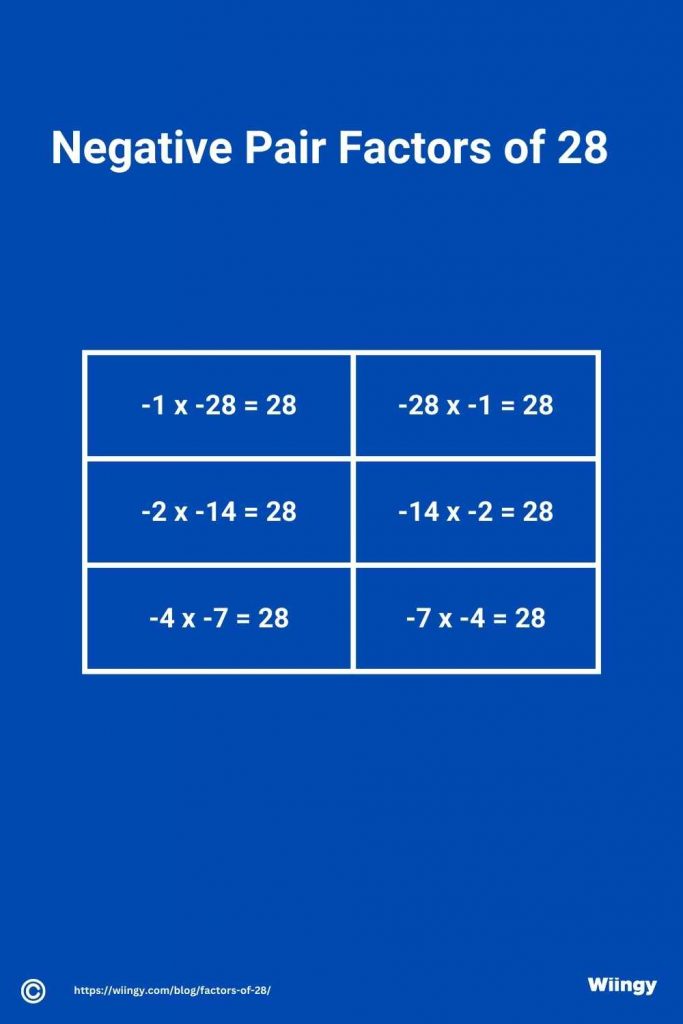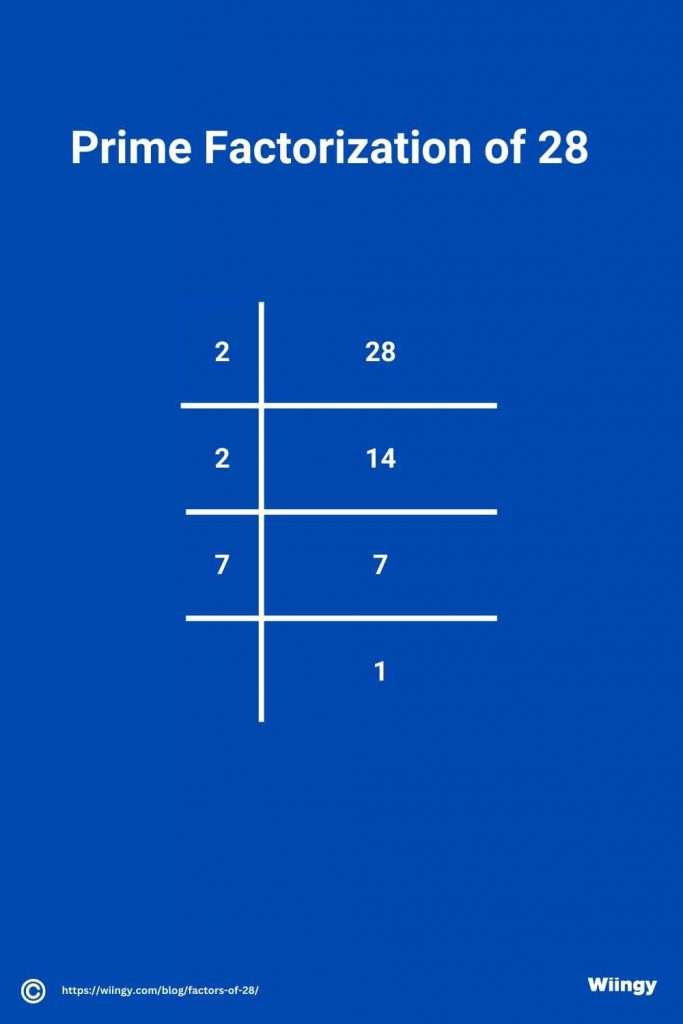Factors of 28 | Prime Factorization of 28 | Factor Tree of 28
Written by Prerit Jain
Updated on: 15 Feb 2023
Contents
Factors of 28 | Prime Factorization of 28 | Factor Tree of 28
When two numbers are multiplied together to get the result of 28, they are called factors of 28. The pair factors of 28 can be written in either positive or negative form. In this article, you will be learning about factors of 28 using the factor tree method, prime factorization method, and division method.
What Are the Factors of 28?
The numbers that divide 28 without leaving any remainder are known as factors of 28. The factors of 28 can be represented in both positive and negative forms. Prime numbers and composite numbers are the two major classifications found in the factors of 28. Any number which contains more than two factors is called a composite number. A number that has two factors or less than two factors is called a prime number. Since 28 has more than two factors it is called a composite number. The factors of 28 are 1,2,4,7,14 and 28.
| Factors of 28: 1,2,4,7,14 and 28. |
| Negative Factors of 28: -1,-2,-4,-7,-14, and -28. |
| Prime Factorization of 28: 2 X 2 X 7 |
| Pair Factors of 28: (1,28), (2, 14), and (7, 4). |
| Prime Factors of 28: 2 and 7 |
| Sum of Factors of 28: 56 |
| Sum of Prime Factors of 28: 9 |
What Are the Factors of 28 in Pairs?
The factors of 28 can be both positive and negative. The combination of two numbers is called a pair factor of 28. When we multiply the pair factors of 28, the result will always be 28 and we will always get the original product.
Positive Pair Factors of 28
The positive pair factors of 28 are (1, 28), (2,14), and (7, 4).

Negative Pair Factors of 28
The negative pair factors of 28 are (-1,-28), (-2, -14), and (-7, -4).

How to Find Factors of 28 Through Division Method?
Any numbers that divide 28 without leaving any remainder are known as factors of 28. Through the division method, we can find the factors of 28 by a dividing sequence of numbers. The steps are mentioned below for your clear understanding.
- 28 ÷ 1 = 28
- 28 ÷ 2 = 14
- 28 ÷ 4 = 7
- 28 ÷ 7 = 4
- 28 ÷ 14 = 2
- 28 ÷ 28 = 1
What Is the Prime Factorization of 28?
In the prime factorization method, you have to check whether the number 28 is a composite number or a prime number. Here, 28 is a composite number because it contains more than two factors, as we mentioned above. For your better understanding, we outlined everything in detail.
- Step 1: Divide the number 28 by the smallest prime number that can divide evenly. That number is 2.
28 ÷ 2 = 14 - Step 2: We get 14 as the quotient. Now, divide 14 by the smallest prime number which is 2.
14 ÷ 2 = 7 - Step 3: The next quotient we got is 7. Dividing 7 with 7 gives us 1.
7 ÷ 7 = 1
The final quotient is 1. Since it cannot be divided further, the prime factors of 28 are 2 X 2 X 7 or 22 X 7. We can also write it down as 2 and 7, as both of them are prime numbers.
The prime factorization for 28 can be represented below:

We can see that 1, 2, 4, 7, 14, and 28 are the numbers that do not leave any remainder when divided by 28. Thus they are the factors of 28.
What Is the Factor Tree of 28?
Students can also use the factor tree to find the 28 prime factors. Let’s take 28 at the top of the factor tree. Then split the factors into factors and write down the set of the pair factors. This process is continued until the pair of factors turn into prime numbers. Finally, by identifying all the prime numbers we will get a prime factor of 28. The detailed steps on how to do this are explained below:
Step 1: Let’s place the number 28 at the top and write down 28 in pairs, that is, 2 and 14.
Step 2: We get 14 as the quotient. Now, divide 14 by the smallest prime number which is 2.
14 ÷ 2 = 7
Step 3: The branches in the factor tree will now be all the prime numbers.
Circling all the branches, 1 X 7 X 2 X 2 or 22 X 71 = 28, which are 28 prime factors.
There are many ways in which we can write the factor tree of 28. Below is an image representation of the factor tree of 28, choosing 2 and 26 as pair factors of 52.

Solved Examples of Factors of 28
What is the sum of all the factors of 28?
The sum of all the factors of 28 is 56.
What are the factors and prime factors of 28?
Factors of 28: 1,2,4,7,14 and 28.
Pair Factors of 28: (1,28), (2, 14), and (7, 4).
What are the prime factors of 28?
The Prime factors of 28 are 2 and 7
Frequently Asked Questions
Does 28 is a prime number?
A number that has two factors or less than two factors is called a prime number. Since 28 has more than two factors it is called a composite number. The factors of 28 are 1,2,4,7,14 and 28.
How do you factor 28 prime?
The prime factors of 28 can be found out using the prime factorization method.
In the prime factorization method, you have to check whether the number 28 is a composite number or a prime number. Here, 28 is a composite number because it contains more than two factors, as we mentioned above. For your better understanding, we outlined everything in detail.
• Step 1: Divide the number 28 by the smallest prime number that can divide evenly. That number is 2.
28 ÷ 2 = 14
• Step 2: We get 14 as the quotient. Now, divide 14 by the smallest prime number which is 2.
14 ÷ 2 = 7
• Step 3: The next quotient we got is 7. Dividing 7 with 7 gives us 1.
7 ÷ 7 = 1
The final quotient is 1. Since it cannot be divided further, the prime factors of 28 are 2 X 2 X 7 or 22 X 7. We can also write it down as 2 and 7, as both of them are prime numbers.
How do you find the factors of 28?
The factors of 28 can be found by using the following methods:
1. Division Method
2. Prime Factorization Method
3. Factor Tree Method
What are the multiples of 28?
The very first multiples of 28 are as follows: 56, 84, 112, 140, 168, 196, 224, 252, 280, and 308.
Is 28 an even number?
Yes, 28 is an even number, as it’s divisible by 2.
Written by by
Prerit Jain
